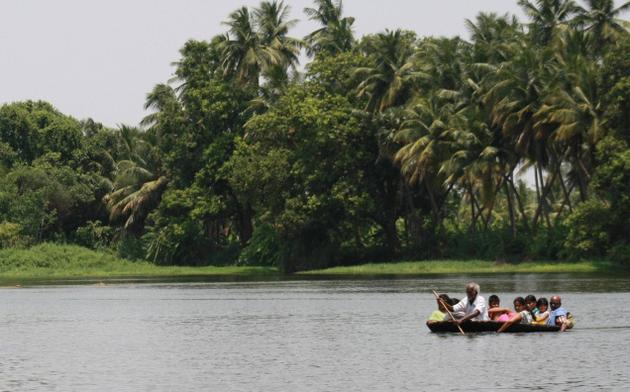AN OUTING ON THE RIVER With a coracle ride and fried fish fresh from the morning’s catch Photo: M. Periasamy / The Hindu
Enjoy a coracle ride down the Bhavani as mango and coconut groves pass you by, says Akila Kannadasan
“Do you want it fried crisp or tender?” asks Chinna Rani as she flips sizzling slices of fish in the kadai. Seated in a temporary shanty facing the frothy waters of Kodiveri, we see children, men, and women young and old splashing about, unmindful of the afternoon sun. Chinna Rani transfers the fish onto a plate and hands it to us. “Ten days ago there was a lot of water in the anaicut. There’s bound to be more in a few days,” she informs us.
There are several such temporary enclosures in Kodiveri where local women sell fish caught in the waters. Tourists head here straight after a bath to feast on the spicy fish. A plate of rice with fish curry costs just Rs. 20!
Kodiveri anaicut channels water from Bhavani Sagar dam into two canals to irrigate agricultural fields. It is said to be built by a Mysore king in the 17th Century. There are two different worlds on either sides of the anaicut in Kodiveri. On one side, the water is still as far as the eye can see. There are mango and coconut groves along the banks. Coracles with tourists float by lazily and you can even catch sight of a pond heron or two.
On the other side, it is utter chaos. It’s here that tourists make merry — they wade about in the foaming waters that gush forth from the rock surface. Little boys in shorts play in the water; a young couple walks in gingerly holding hands; a mother calls out to her son who walks too close to the current; a man floats on his back, eyes half-closed; women in saris squeal as they hit the water — one is holding a baby in her arms.
An entourage from a nearby village is gathered on the banks for a ritual. A select few will carry pots of water from Kodiveri for Karupparayan, their deity. The party walks off with the pots balanced on their heads, led by a group of men who play the thappu, a traditional percussion instrument. It’s a practice that’s being followed for many years at the start of the yearly temple festival. Kodiveri’s waters serve as the theertham to a lot of temples nearby.
We decide to try the coracle ride — it’s the main attraction at Kodiveri. For Rs. 30 per head, the boatman will take you as far as the mango groves at the far side. Manickam, a fisherman, takes us on a coracle he built himself with 10 others! “It’s made entirely of bamboo. There are two sacks around it, held together by tar so that water doesn’t come inside,” he explains. Manickam skilfully manoeuvres the coracle against the current. “I’ve been doing this for 10 years,” he says, as he negotiates a branch that sticks out from an ageing athitree at the edge of the water.
“Shall I make it go round and round?” he asks, towards the end of the ride. We nod, unsure of what he meant. He propels the oar backwards forcefully — the coracle describes a small circle. He repeats the movement in the same direction, and then it begins. The coracle wheels around in the water like a carousel. We scream in excitement. A passenger asks him to stop. But Manickam doesn’t seem to be listening.
source: http://www.TheHindu.com / Home> Life & Style> Travel / by Akila Kannadasan / May 31st, 2012
